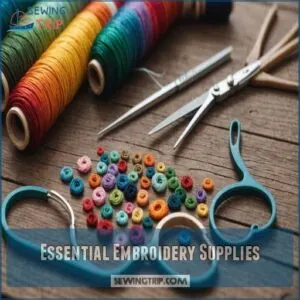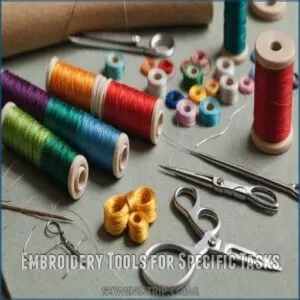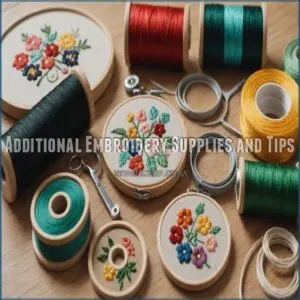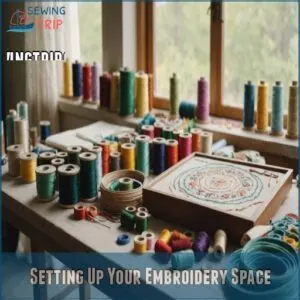This site is supported by our readers. We may earn a commission, at no cost to you, if you purchase through links.
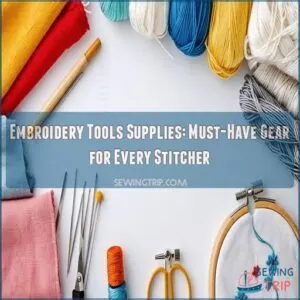 When you’re ready to embroider, gather essential embroidery tools supplies like a trusty hoop, your fabric’s best friend.
When you’re ready to embroider, gather essential embroidery tools supplies like a trusty hoop, your fabric’s best friend.
Choose quality embroidery needles and floss—think of them as your brush and paint.
Organize your threads with floss holders so they don’t create their own chaotic masterpiece.
A sturdy fabric marks your canvas, while those sharp embroidery scissors will snip with precision.
Don’t forget a needle threader; you’ll thank it later.
Slip on a thimble to safeguard your hardworking finger.
Marking pens keep your designs straight, leaving no room for guessing games.
Curious about fabric choices? That’s where the fun really begins!
Table Of Contents
Key Takeaways
- Keep your embroidery tools organized. Use labeled containers for floss and small bins for needles, ensuring everything is within reach for efficient workflow.
- Select the right needles and scissors. Choose from crewel, tapestry, or milliner needles based on your fabric type, and keep your embroidery scissors sharp for precise cuts.
- Choose quality threads and fabric. Opt for stranded cotton or pearl cotton and consider using stable woven fabrics like linen for better control and detail in your designs.
- Ensure proper lighting and workspace setup. Use LED lamps with adjustable arms for optimal lighting, and select an ergonomic chair to maintain comfort during your embroidery sessions.
Essential Embroidery Supplies
Embroidery requires a few essential supplies to get started, including hoops, needles, scissors, and threads. Mastering the basics helps your fabric stay taut and stitches come out perfect every time.
Embroidery Hoops and Frames
Embroidery hoops and frames are essential. They keep your fabric taut and your stitches neat. Here’s a quick rundown to guide you:
- Hoop Sizes: Bigger isn’t always better. Match the hoop to your design’s size.
- Frame Types: Choose between wooden or plastic frames.
- Hoop Tension: Adjust for fabric type.
- Frame Alternatives: Explore adjustable frames!
Embroidery Needles and Scissors
So, you’ve mastered hoops! Now, let’s talk needles and scissors.
For hand embroidery needles, needle sizes range from 1 (largest) to 12.
A crewel needle or tapestry needle might be perfect for you.
Sharp embroidery scissors are a must for precise snipping.
Keep them sharp!
Proper storage prevents damage and keeps everything organized.
Troubleshooting? A dull needle or blunt scissors will quickly frustrate you.
Embroidery Floss and Pearl Cotton
Thinking about your needlework, let’s unravel the wonders of embroidery floss and pearl cotton.
The right threads bring your designs to life.
Consider these essentials:
- Floss Types: Explore stranded cotton for versatility.
- Thread Count: Make sure the right thickness for your fabric, and for a wide selection of embroidery kits, check out Embroidery Kit Options.
- DMC vs. Anchor: Choose your favorite brand for vivid colors.
Play with color theory and care for your threads.
Marking Tools and Needles
Once you’ve selected your embroidery floss, focus on transferring designs.
A well-chosen marking tool, like water-soluble markers or fabric markers, is your guide to perfect stitches.
Match needle types to your fabric: crewel needles for general use, milliner needles for specialty tasks.
Choosing the right needle size affects your hand embroidery designs’ precision and elegance beautifully.
Choosing The Right Fabric
When you’re starting your embroidery project, selecting the right fabric is essential for achieving a polished result.
Consider materials like woven fabrics and felt, paying attention to thread count and flexibility to prevent any surprises in your finished piece.
Woven Fabrics
Choosing woven fabrics is important for embroidery success.
Consider these tips to avoid common pitfalls:
- Woven fabric types: Pick something stable like linen.
- Fabric weight: Lighter is often better.
- Thread count: Higher counts create finer detail.
- Fabric care: Choose easy-care options.
- Project ideas: Start simple, progress to complex.
These considerations help you create satisfying embroidery projects.
Felt and Other Non-Woven Fabrics
As you explore fabric choices, felt stands out with its thick texture and non-fraying edges, making it ideal for unique embroidery projects.
Unlike woven fabrics, felt and other non-woven types offer a sturdy canvas for playful designs.
Whether creating bold embroidery techniques or seeking the perfect tools to embroider letters on shirt, such as chenille hand needles, or crafting delightful project ideas, these fabrics open up a world of possibilities in your embroidery supplies.
Thread Count and Fabric Selection
Switching from felt’s warmth to the fine art of fabric selection, let’s talk thread count and fabric weight. These are your new best friends. Choose wisely:
- Aida cloth’s firmness for crisp stitches.
- Linen fabric’s elegance for advanced techniques.
- Even weave’s consistency for smooth projects.
- Hand embroidery supplies that match your style.
Control your designs, master your threads!
Embroidery Tools for Specific Tasks
Now you’ll discover that mastering embroidery techniques for best hooping is crucial for perfect designs, and then discover specialized needles perfect for different embroidery techniques. We’ll explore crewel, tapestry, and milliner needles, each designed for specific stitches and fabric types.
Crewel Needles
Crewel needles are ideal for vintage embroidery and modern projects alike.
They’re medium-length with a sharp tip and large eye for easy threading.
When choosing a crewel needle, consider the needle sizes, which range from 1 to 12.
Make sure to maintain crewel needle care to enjoy long-lasting stitching.
Here’s a quick reference to guide you:
| Task | Needle Size | Description |
|---|---|---|
| Fine details | 10-12 | Small, precise work |
| Medium work | 7-9 | Versatile stitching |
| Bold stitches | 1-6 | Thick threads |
Tapestry Needles
Tapestry needles are your go-to for hand embroidery, especially with cross-stitch or needlepoint projects.
With their blunt tips, they prevent fabric damage while guiding threads smoothly through woven and even-weave fabrics.
When choosing a tapestry needle, consider the canvas type, such as 14-count canvas for beginners, to make sure you have a smooth stitching experience.
When working with embroidery needles, choosing the right type for your fabric is crucial, as sharp points for dense fabrics can make a big difference in your project’s outcome. Use a needle size guide to match your project’s needs; these versatile tools blend seamlessly into your embroidery patterns.
Pair them with a thread cutter for ultimate stitching convenience.
Milliner Needles
Tired of tangled threads?
Meet the milliner needle—a favorite for its long shaft and almost round eye, perfect for bullion knots and French knots.
Unlike tapestry needles, these have sharp points.
Check the milliner needle size guide before picking yours.
Whether you’re working with delicate or stretchy fabrics, choosing the right stable support for embroidery is crucial for achieving professional-looking results. Whether you’re crafting vintage-inspired projects or using the latest embroidery machines, this needle helps to create precise, beautiful stitching every time.
Additional Embroidery Supplies and Tips
To enhance your embroidery toolkit, consider adding temporary fabric spray adhesive, stabilizers, and quality bobbins to your collection.
These additional supplies streamline your stitching process, ensuring your projects are both efficient and enjoyable.
Temporary Fabric Spray Adhesive
Imagine using temporary fabric spray adhesive for quick project fixes.
It’s like magic glue for fabric, making embroidery easier.
Always apply in a well-ventilated area to avoid sticky mishaps.
For those working with delicate or loose fabrics, consider pairing it with a sturdy embroidery hoop frame.
Many brands offer this in convenient sizes.
Just a quick spray aligns material without hassle.
Practical and versatile, it’s a handy tool you shouldn’t overlook!
Embroidery Stabilizers
To achieve a professional finish in in-the-hoop embroidery, understanding stabilizer options. Choosing the right embroidery stabilizer is essential for a polished design.
Think of stabilizers as the unsung heroes of embroidery, keeping your fabric steady and stitches even.
To master the use of stabilizers, understanding hooping techniques for stabilizers is key.
Types of stabilizers include:
- Tear-away: Easily removed, great for stable fabrics.
- Cut-away: Provides lasting support for stretchy fabrics.
- Water-soluble: Dissolves in water, perfect for delicate projects.
Each type offers unique stabilizer uses and benefits!
Embroidery Bobbins and Threads
Now that you’ve mastered stabilizers, let’s talk bobbins!
Proper bobbin winding is key to even thread tension.
When choosing the right thread for your project, consider the benefits of different thread types, such as the vibrant sheen and smooth performance of rayon embroidery thread types. Experiment with different bobbin sizes and thread weights to find what works best for your projects and your embroidery thread types.
Remember, consistent thread tension is your secret weapon for beautiful stitches!
Don’t forget to check your bobbin frequently to avoid frustrating mid-project snags.
Setting Up Your Embroidery Space
Creating an efficient embroidery space starts with organizing your supplies neatly within reach to avoid any mid-stitch interruptions. Choose a well-lit workspace that’s comfortable, ensuring your creativity flows without hindrance.
Organizing Your Supplies
Keeping embroidery supplies organized transforms chaos into creativity.
Use clever storage solutions like labeled containers for floss and small bins for needles.
Maintain a supply inventory to track essentials.
Your embroidery kit deserves a tidy home, boosting efficiency and joy.
Craft room organization can feel like taming a wild thread—satisfying and essential for peace amid your stitching haven.
Choosing The Right Workspace
Imagine creating a cozy nook that inspires your creativity.
Start with good lighting to see every stitch clearly.
Make sure your workspace is ergonomic to keep you comfy during long projects.
Incorporate smart storage solutions for easy access to supplies.
A touch of comfort, like a soft cushion, enhances your mood, making embroidery sessions both relaxing and productive.
Tips for Efficient Embroidery
Got your workspace sorted? Let’s stitch with finesse! Here’s how to boost productivity:
- Label your threads for hassle-free selection.
- Keep tools within arm’s reach to prevent disruptions.
- Use a pin cushion to organize needles efficiently.
- Plan your project layout on paper, saving time and ensuring neatness.
Embroidery techniques will shine!
Frequently Asked Questions (FAQs)
What are the 6 basic tools for embroidery?
You’ll need embroidery hoops, needles, scissors, floss, fabric, and a marking tool. These are your essential starting points for beautiful embroidery! Grab them, and let’s create!
What are the materials needed for embroidery?
Perhaps in another galaxy, you might find a more delightful hobby than embroidery.
You need needles, hoops, scissors, embroidery floss, pearl cotton, and fabric like aida cloth or muslin.
Add marking tools for design accuracy.
What supplies do I need to start embroidering with a machine?
To start machine embroidering, you’ll need an embroidery machine, embroidery needles, spools of polyester or rayon thread, stabilizers, and embroidery hoops.
Don’t forget a USB stick for designs and scissors for trimming threads efficiently.
What is the most essential tool in hand embroidery?
Like a best friend in your embroidery adventure, the hoop is essential.
It holds your fabric taut, preventing puckering and ensuring even stitches.
Choose one that fits your design perfectly, keeping your canvas ready for creativity.
How do I organize my embroidery threads?
Organize your embroidery threads by wrapping them around plastic or cardboard bobbins, storing them in a box or creating a color-coded system using floss bags.
This keeps everything neat and prevents frustrating tangles and knots.
What are the best lighting options for embroidery?
Lighting is important for embroidery enjoyment.
Use LED lamps for bright, consistent light that won’t strain your eyes.
Opt for adjustable arms to focus light precisely.
Magnifying lights can help you see intricate details without frustration.
How can I avoid tangling embroidery floss?
Keep your floss neatly wound. Use a floss bobbin or container. Avoid pulling out long lengths at once. This prevents frustrating tangles, letting you stitch freely!
What is the ideal chair for embroidery work?
The ideal chair for embroidery is like your trusty steed—reliable and comfortable.
Look for supportive backrests, adjustable height, and cushioned seats.
Ergonomic designs help prevent strain, allowing you to stitch away hours without discomfort.
How do I clean and store finished embroidery projects?
Gently hand wash your embroidery with mild soap, then dry flat.
Store it by rolling loosely in acid-free paper or placing it in a breathable box.
This protects against dust and preserves your work beautifully over time.
Conclusion
Expand your creativity with embroidery tools and supplies, transforming visions into vibrant art.
With hoops in hand, needles sharpened, and threads untangled, you’re ready for countless creations.
Select the right fabric and tackle each project with precision, using marking pens to guide and sharp scissors to perfect.
Keep your space organized, making each stitch count.
Embroidering is more than a pastime—it’s an expression.
Embrace every detail and watch your skills and satisfaction grow.

